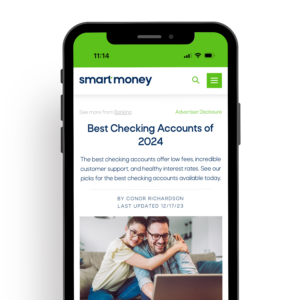Takeaways
- Consumer debt is classified by the type of product you are using.
- Most debt falls into two categories: secured and unsecured debt.
- Debt can help you buy items you wouldn’t otherwise be able to purchase.
- Credit score and credit history determine the terms you receive from lenders.
- Debt management is a critical aspect of successfully handling your debt over time.
Some of the links in this article are from advertising partners of Smart Money, which does not influence our evaluations or recommendations. We work to provide you with accurate and reliable information. Our opinions are our own.
What is Consumer Debt?
Consumer debt is the amount of money owned by consumers who purchase goods and services on credit. On its surface, consumer debt is simply one person owing another money. However, depending on the type of debt and what it is used to purchase, debt can be complicated.
Debt is considered a financial tool to help you purchase more than you could with cash. Debt management is keeping track of all your debts and ensuring you make payments so that your debt does not start to ruin your finances. Many consumers become lackadaisical with debt and take on too much debt. For these folks, getting debt relief can be a lifeline.
Many finance professionals advocate using consumer debt but argue that you should keep your debt to a reasonable level. Creating a budget, like the 50/30/20 budget, can help you maintain the lifestyle you want while paying off your debt.
Paying your debts on time and in full will help increase your credit score. A high credit score will get you better terms for taking out debt in the future.
Let’s look at how debt breaks down.
Two Categories of Debt
In general, debt can be split into two main categories: secured and unsecured. Secured and unsecured debt are separated by the lenders’ ability to recover their losses if you default on your debt.
- Secured Debt: Secured debt is backed by an asset the lender can try to repossess if you do not pay your debt. For example, if you purchase a new car with an auto loan, that loan is secured by the new car. If you don’t make your payments on time or at all, the lender can technically seize your vehicle to pay off the car note.
- Unsecured Debt: Unsecured debt is the opposite of secured debt. With unsecured debt, the lender issues debt with no asset the lender can seize if you default. For example, if you open a new credit card account and rack up a huge bill you do not pay, the lender cannot take possession of the goods you purchased with the credit card. However, the credit card lender can sell your debt to a debt collector who may take aggressive action to reclaim the funds.
Smart Tip:
Some credit cards that help consumers with low credit scores build up credit are backed by cash as collateral.
6 Types of Consumer Debt
Now that you know how secured and unsecured debts work, let’s explore the six main types of consumer debt products. These financial products are issued by banks, credit unions, or lending institutions specializing in a specific product (e.g., mortgage providers).
1. Credit Cards
Americans love using credit cards. According to the Federal Reserve and U.S. Census Bureau, Americans own approximately $1.13 trillion in credit card debt [1].
Credit card debt is one of the most common forms of unsecured debt. Credit cards have high annual percentage rates (APY) that range in the double digits from the mid-teems to the 20s.
Although credit cards can be an expensive form of debt, they do offer attractive benefits to consumers.
Credit cards offer reward programs that many customers find attractive. You can earn travel rewards, cash-back offers, and other unique offers based on your credit history and credit score. Explore the best credit cards on the market to get the best bang for your buck.
Paying off your credit card debt can be hard with a high debt-to-income ratio. Here are a couple of ways to help solve a credit card bill:
- Create a debt repayment plan.
- Transfer your debt to a 0% APR balance transfer card.
- Consult a financial advisor about debt repayment strategies.
- Consolidate your debt to ease payment management.
Get Smart With Your Money
Fresh weekly articles delivered straight to your inbox.
Enter your name and email for free tips and tricks.

2. Student Loans
The cost of higher education has skyrocketed over the last several decades. Although student loans provide a valuable resource to finance your education, they can impede achieving your financial goals after graduation.
The two main categories of student loans are federal student loans and private student loans. Most financial advisors advocate to get as much money from family and friends, scholarships, grants, or other sources of free cash as you can. Once you have exhausted those options, you can focus on securing the financing you need to attend your dream school. Start with federal student loans and migrate to using private student loans.
Remember that student loans are unsecured debt backed by your potential earning capacity. If you want to get debt-free, here are a couple of ways to help get you there:
- Budget for a percentage of your take-home pay for student loan payments.
- Pay more than the required minimum payment.
- Put cash windfalls (bonuses, inheritance, gifts) toward student loan debt.
- Consider ways to earn more income to pay extra payments.
3. Auto Loans
If you want to buy a new car, you might need financing to make the purchase. Auto loans are another form of secured debt because the note is backed by your car. The most common terms for a car loan are 24, 35, 48, 60, 72, and even 80 months.
With inflation and the rising cost of cars stressing budgets, many buyers have opted for longer-term payments to help with affordability. The average auto loan length is 68 months for new cars [2]. With auto loans getting longer and more expensive (because of interest payments), you want to ensure you have budgeted for car payments.
Read More -> Save More with Pay Yourself First Budgeting
Paying off your car loan can be a smart money move. Here are some ways to help you reach that goal faster:
- Make larger payments to your principal.
- Sell your car and buy a less expensive car.
- Consider refinancing your auto loan.
4. Mortgages
In the U.S., mortgages make up the largest percentage of household debt. As a multi-trillion-dollar product offering, mortgages are loans issued by banks, credit unions, and mortgage lenders to help you purchase real estate with debt [3].
Buying a home is one of the biggest financial decisions you can make, and it often involves getting a mortgage. Unless you have saved enough cash to purchase a home, you will probably need to take out a mortgage to buy your dream house. This means you will need to save for a down payment and ensure you have a proper financial cushion to take on the hidden costs of homeownership.
Mortgages are another form of secured debt. If you don’t make on-time mortgage payments, you risk defaulting on your loan, and lenders can take your house because it is collateral for your mortgage. If you having trouble keeping up with your mortgage, you can think about implementing the following tactics:
- Reduce your debt-to-income ratio.
- Downsize your house to one that is more affordable.
- Refinance your mortgage when interest rates are low.
- Save a slush fund to ensure you can meet monthly payments.
5. Personal Loans
Personal loans are a form of unsecured debt that allows you to take out debt to fund various projects like remodeling your home or paying unexpected bills. If you have a high credit score, banks and other lenders will issue a personal loan at interest rates lower than your credit card.
Personal loan terms can range from a couple of months to multiple years. Budgeting for your monthly payment is a critical part of personal loan affordability.
If you don’t have an amazing credit score, do not worry. Companies like BadCreditLoans specialize in lending to customers with poor credit scores. Explore your options to find the best personal loan for your financial situation.
If you are having trouble paying off your loans, here are a few ways to accelerate the process:
- Reduce the scope of projects that require a personal loan.
- Automate your debt payment to ensure on-time payments.
- Liquidate investments (stocks, bonds, real estate) to pay your loan.
6. Payday Loans
Payday loans are short-term loans with high-interest rates. These loans are typically given for smaller amounts of cash – $300, $400, $500 – and are due once you receive your next paycheck. Many payday loans must be paid back within a couple of weeks.
The rules and regulations on payday loans vary from state to state. For those that allow payday loans, there is usually a ceiling on the fee or annual percentage rate (APR) the payday lender can charge you. However, a standard two-week payday loan can charge $10-$30 per $100 loaned. Because these are nominal amounts, it doesn’t seem that costly. However, a $15 fee on a $100 two-week loan equates to 400 percent [4].
If you are trying to pay off a pesky payday loan, try these strategies:
- Ask family or friends for cash or a gift.
- Sell unused items on an online marketplace (e.g., Facebook Marketplace, Craigslist)
- Start a side hustle to earn extra cash.
- Earn more income by starting an online business.
Smart Summary
Consumer debt helps millions of people get the financing they need. When you run short on cash, you can rely on sources of debt to help bridge you to your next paycheck or cash infusion. Relying on debt too much can leave you saddled with debt payments. Debt repayment strategies can lower your debt-to-income ratio. You want to keep your credit score clean with consistent and on-time monthly payments. This will decrease the cost of your borrowing in the future.
You Might Also Like:
Read More -> What is a FICO score?
Read More -> What is a VantageScore?
(1) Center for Microeconomic Data. Household Debt and Credit. Last Accessed March 25, 2024.
(2) Experian. Average Auto Loan Debt Grew 5.2% to $23,792 in 2023. Last Accessed March 25, 2024.
(3) Center for Microeconomic Data. Household Debt and Credit. Last Accessed March 25, 2024.
(4) Consumer Financial Protection Bureau. What is a Payday Loan? Last Accessed March 25, 2024.










